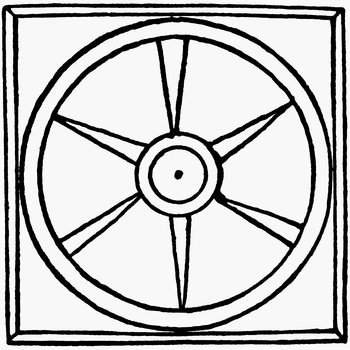
Bandcamp hosts an amazing array of field recordings from around the world, made by musicians and sound artists as well as professional field recordists. In this column, we highlight the best sounds recorded outside the studio and released in the last month. This installment is full of landscapes, featuring recordings from the Australian outback and the Texas panhandle; an English pond and the Brazilian rainforest; the canals of Venice and the streets of London.
Michael Pisaro-Liu
A room outdoors






Compact Disc (CD)




Michael Pisaro-Liu is a key member of the Wandelweiser Group, a collective of composers interested in silence, quiet sounds, and long durations. In the mid-2000s, Pisaro-Liu began incorporating field recordings into his practice, troubling the distinctions between sound and silence, composition and contingency. A room outdoors, from 2006, is the first of his compositions to be based on field recordings, but it’s only seeing its recorded debut now. The score calls for any sustaining instrument to play alongside pre-recorded field recordings. As Pisaro-Liu describes, “In this piece, the field is brought indoors. In the best realizations (such as the two on these recordings), the piece brings about a reversal, where the walls seem to be on the verge of disappearing.” The first performance here, in Brussels with Guy Vandromme on keyboards and Adriaan Severins on synthesizer and field recordings, features long drones that intertwine with sounds of the city. The screech of the subway harmonizes with the players while footsteps perform an unconscious beat, revealing the musicality of the scene as in Pisaro-Liu’s Transparent City, which adds subtle sine tones to recordings of Los Angeles. The performance in Cremona, with Vandromme on harmonium and Luciana Elizondo on viola da gamba playing over field recordings by Fabio Gionfrida, takes a different tack. The players’ volume swells until they overwhelm the recordings, then subside to reveal a change in scenery. Just as we’re re-acclimated to the untreated recording, the instruments again compete for attention. These two approaches to the piece create much the same effect—a new awareness of the musicality of the world, at times resonating with itself in serendipitous harmony.
Sam Dunscombe
Two Forests / Oceanic



Vinyl LP

Sam Dunscombe—composer, clarinetist, Horațiu Rădulescu scholar—has turned their roving mind toward psychedelic-assisted psychotherapy after finding that the music deployed by psychiatrists in sessions with patients on LSD, MDMA, and psilocybin is standard Western classical fare mixed with a bit of New Age or ambient. “One piece of advice was, wait until the person is at the peak of their experience and then you hit them with Debussy’s Clair De Lune,” they confided to The Wire. Seeing the potential for a more effective musical environment, Dunscombe combined field recordings and just intonation—both areas they’ve explored before—to create “a sense of place-gone-strange.” “Two Forests” connects a California sequoia grove to the Brazilian Amazon via a bridge of digitally synthesized tones based on the pitches of bird and insect calls. “Oceanic” combines several beach recordings that are overlaid with tones determined by the waves’ rhythms. As each track develops, they create alternative spaces that subtly expand and contract. Dunscombe promises “beneficial psychological results” even outside of therapy—a bold claim borne out by the peaceful effects of these stellar recordings.
Action Pyramid & Jack Greenhalgh
Mardle: Daily Rhythms of a Pond





Compact Disc (CD)



For much of the 20th century, draining a pond for agriculture or urban development was unremarkable because there were simply so many of them dotting the landscape, sometimes four or five to a field. But this is no longer the case. Over the last 100 years, the number of ponds in the UK has declined by 75%. Acoustic ecologist Jack Greenhalgh and sound artist Action Pyramid draw attention to this crisis by focusing on one pond in particular, the Mardle, outside of Lowestoft, England. Inspired by Jana Winderen’s underwater recordings, the duo used hydrophones to record a full day of subaquatic activity. They revealed a complex ecosystem governed by a natural biorhythm. During the day, the sonic environment is dominated by plants’ photosynthesis, which emits percussive pops and oddly synthetic buzzes (like those recorded by Ludwig Berger earlier this year). At night, the insects take over with stridulations much like crickets or cicadas above the water. For scientists, this is a great step forward in acoustic ecology: “It’s so exciting that we’ve discovered the woodland bird song dawn chorus equivalent for ponds, in the form of nocturnal aquatic insect choruses at nighttime, and the whining of aquatic plants as they photosynthesize like busy factories during the midday sun,” explains Greenhalgh. For the casual listener, it’s just as fascinating, a glimpse into an overlooked habitat suddenly brimming with life and sound.
Jean-Baptiste Geoffroy
Local Exoticism






Cassette




Part of the appeal of field recording is the opportunity to hear sounds from around the world, from the Arctic Ocean to the Sahara Desert. But as Jean-Baptiste Geoffroy points out, this can lead to a sort of sound-envy, a pining after “exotic” sounds at the expense of what might be found right outside. Geoffroy addressed this problem by confining himself to a two-kilometer area around his home for Local Exoticism. The A-side consists entirely of recordings taken near the Loire River in France, collaging the weather, water, and wildlife into a snapshot of his daily environs. The B-side takes these recordings and warps them into a slower, stranger representation of the same space. The paradox is that, for listeners, Geoffroy’s path on the banks of the Loire is itself exotic; both of these tracks introduce us to a soundworld that we are unlikely to inhabit. But Local Exoticism works in two ways, as a fascinating document of a specific place and, more importantly, as an invitation to treat our own surroundings with the same intensity of focus and spirit of curiosity.
Kate Carr
A Field Guide to Phantasmic Birds



Compact Disc (CD)

Lately, Kate Carr has been inventing birds out of whole cloth, whether with glitching electronics on Mappa’s recent collection of Synthetic Bird Music or with bells, whistles, and horns on her Foley-inspired False Dawn. On A Field Guide to Phantasmic Birds she goes in the opposite direction, taking recordings of real birds from South Africa, Australia, and the UK, and transforming them into an alien soundscape. With track titles that could be taken straight out of a field guide, it’s easy to imagine these songs soundtracking an expedition through an otherworldly forest. “A loud hissing screech which drops in pitch halfway” is full of fluttering and chittering over an ominous bass drone as if we’re slowing paddling through a dangerous swamp; by the time we get to “Shy, typically alone or in pairs” we’ve reached a peaceful clearing of aeolian tones and gentle calls. It’s a strange journey, but one definitely worth taking.
Enrico Coniglio
Lopa


Venice has historically been a symbol of man’s ingenuity, but the city is now at risk of destruction through man-made climate change; some experts predict it will be underwater within the century. Lopa was recorded outside of Venice, in the small islands and lagoons that surround the waterlogged city. Enrico Coniglio ventured out to those spaces in the middle of the night, in winter, to ensure that the presence of people wouldn’t interfere with the “voice of the environment.” Still, machines make their mark. “Route A” features the natural sounds of water lapping against the piers, but “Route B” soon runs into the overwhelming rumble of an engine. Similarly, the three-part “Lopa” suite features Coniglio’s own interventions into the soundscape, with alarming beeps and buzzes that seem to signal a cataclysmic end. At the end, only the quacking of Venice’s famous ducks remain. “The possible sound portraits of a place appear infinite, like a game of mirrors: among the many “Venices,” choosing to focus on one cannot claim any adherence to reality,” Coniglio writes. Still, the portrait that he paints is realistic enough, a beautiful snapshot of the city as well as a warning of its fate.
Sarah Ruth
Fellowship of the Arid Plain




, Compact Disc (CD)


The empty prairie on the cover of Sarah Ruth’s Fellowship of the Arid Plain does not suggest a riot of sound. Yet, in these recordings from the Alexander Home Place in the Texas Panhandle we find a panoply of genres: vocal improv (“Improv With Unknown Insect”), noise (“The Wind Plays Harsh Noise Set in Tractor Shed”), and gospel (“Rock of Ages”). We hear birds, insects, and thunder; we hear cattle and people imitating cattle. But most of all, we hear Sarah Ruth with her friends, walking, singing, banging on farm equipment and playing guitar, harmonica, and didgeridoo. We learn a lot about the environment, but even more about the people who live there and make the unforgiving landscape a lively—and yes, noisy—place.
Liz Helman
The Colour of Water



Compact Disc (CD)

The materials that Liz Helman used for The Colour of Water are unremarkable, simply recordings that she made on her daily walks through London. But what she has done with them is anything but ordinary. By applying delay, reverb, and echo, Helman summons massive drones that dwarf her original sounds as if they have been transplanted to a vast filmic landscape. Traffic and street noise is stretched into an otherworldly hum on “Drift”; footsteps, birdsong, and children’s voices take on a grand scale on “Footprints + Feathers”; and a street preacher’s apocalyptic vision sounds increasingly convincing on “Urban Messiah Time Has Told.” Though Helman recorded scenes that were bustling with life, she evokes a desolate urban wasteland, one that is both harrowing and compelling to explore.
Lawrence English & Werner Dafeldecker
Tropic of Capricorn




Vinyl LP


Tropic of Capricorn is the second collaboration between Australian composer, field recordist, and Room40 label head Lawrence English and Austrian bassist, improviser, and electroacoustic artist Werner Dafeldecker. Their first, Shadow of the Monolith, featured English’s recordings of Antarctica that were manipulated by Dafeldecker. For this outing, English stayed a bit closer to home, gathering recordings in the Pilbara region in the north of Western Australia and the land of the Arrernte people in central Australia. These recordings are full of birds, insects, winds and storms, along with train and factory sounds invading from afar. Dafeldecker improvises with the recordings to add an element of uncertainty—is that truly the buzz of a swarm of bees and the rumble of thunder, or some sort of studio trickery? At other moments, as in the delicate piano at the end of “Tropic of Capricorn II,” their roles are more clear-cut, with Dafeldecker responding to the recordings as he would to another improvising musician. In either case, you’ll want to lean in and listen closely to parse this captivating merger between man and nature.







